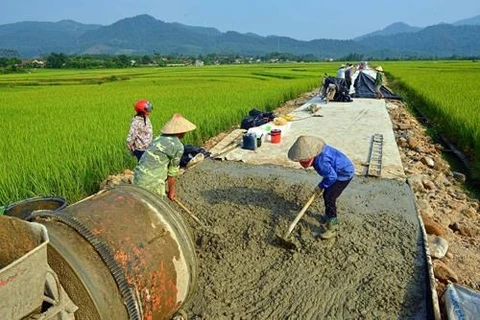Hanoi (VNA) – Total debt for basic construction in the new-style rural area building programme was reduced to about 9.55 trillion VND (434 million USD) at the end of 2016 from over 15.27 trillion VND (694 million USD) early last year, according to the Central Steering Committee for National Target Programmes for 2016-2020.
Seventeen out of 25 provinces with debt of over 100 billion as of January 31, 2016 have managed to trim down their debt to a total 5.62 trillion VND, reported the committee.
In 2016, total capital mobilised for the programme was nearly 228.4 trillion VND sourced from credit loans (59.7 percent), the community (8.5 percent), local budgets (12.3 percent), businesses (5.9 percent) and the central budget (3.2 percent).
During the year, 15 districts and 828 communes were recognised as new-style rural areas, raising the total number of communes fulfilling all criteria of the programme to 2,358, 26.43 percent of total communes nationwide, along with 30 recognised districts. The average commune completed 13.47 out of total 19 criteria.
At a committee meeting on January 10, Minister of Agriculture and Rural Development Nguyen Xuan Cuong noted that 2016 was the first year that the new-style rural area building programme was integrated with the multidimensional poverty reduction programme, adding that the ministry completed a large legal framework supporting the work.
President of the Vietnam Cooperative Union Vo Kim Cu noted that agriculture is attracting interest from large firms, helping speed up the sector’s restructuring, the building of new-style rural areas and poverty reduction.
In 2017, the country aims for 30 percent of total communes to fulfill all the programme’s criteria, a rise of four percent over the previous year.
Meanwhile, Deputy Minister of Labour, Invalids and Social Affairs Nguyen Trong Dam noted that bythe end of 2016, the country’s poverty ratio was about 8.38 percent, a reduction of 1.5 percent year on year. The rate in poor districts was 46.43 percent, down 4 percent year on year.
According to Ministry of Labour, Invalids and Social Affairs, the northwestern mountainous region recorded highest ratio of poverty reduction which varied from 2.7 to 31.8 percent.
General Director of the Vietnam Bank of Social Policy Duong Quyet Thang said that last year, the bank provided 55.15 trillion VND to nearly 2.3 million households. He added that the first year of the multidimensional poverty reduction programme distributed huge amounts of resources through credit policies, while overdue debt was only 0.24 percent.
Thang proposed the ministries of Planning and Investment and Finance adjust charter capital for the bank so it can offer more loans to rural households to build sanitation works.
In 2017, the committee aims for a 1-1.5 percent reduction in the national average ratio of poor households, four percent in poor and ethnic minority localities and an increase of 1.5 times in per capita income of poor households from 2015.
Addressing the meeting, Deputy Prime Minister Vuong Dinh Hue asked the committee to work harder to ensure at least 50 percent of total communes nationwide become new-style rural areas by 2020, and no localities fulfill less than five criteria of the programme.
He also requested the committee set higher targets for the multidimensional poverty reduction programme, while directing ministries and sectors to complete legal framework and finalise all documents for the first quarter of this year, especially those related to capital.
The Ministry of Agriculture and Rural Development was directed to guide the implementation of 19 criteria for the new-style rural area building programme in the first quarter of this year, while publishing a handbook on the programme.
Deputy PM Hue also urged ministries to improve their policies to encourage stronger engagement of businesses in agriculture, stressing that the current rate of firms investing in the sector is too low./.
Seventeen out of 25 provinces with debt of over 100 billion as of January 31, 2016 have managed to trim down their debt to a total 5.62 trillion VND, reported the committee.
In 2016, total capital mobilised for the programme was nearly 228.4 trillion VND sourced from credit loans (59.7 percent), the community (8.5 percent), local budgets (12.3 percent), businesses (5.9 percent) and the central budget (3.2 percent).
During the year, 15 districts and 828 communes were recognised as new-style rural areas, raising the total number of communes fulfilling all criteria of the programme to 2,358, 26.43 percent of total communes nationwide, along with 30 recognised districts. The average commune completed 13.47 out of total 19 criteria.
At a committee meeting on January 10, Minister of Agriculture and Rural Development Nguyen Xuan Cuong noted that 2016 was the first year that the new-style rural area building programme was integrated with the multidimensional poverty reduction programme, adding that the ministry completed a large legal framework supporting the work.
President of the Vietnam Cooperative Union Vo Kim Cu noted that agriculture is attracting interest from large firms, helping speed up the sector’s restructuring, the building of new-style rural areas and poverty reduction.
In 2017, the country aims for 30 percent of total communes to fulfill all the programme’s criteria, a rise of four percent over the previous year.
Meanwhile, Deputy Minister of Labour, Invalids and Social Affairs Nguyen Trong Dam noted that bythe end of 2016, the country’s poverty ratio was about 8.38 percent, a reduction of 1.5 percent year on year. The rate in poor districts was 46.43 percent, down 4 percent year on year.
According to Ministry of Labour, Invalids and Social Affairs, the northwestern mountainous region recorded highest ratio of poverty reduction which varied from 2.7 to 31.8 percent.
General Director of the Vietnam Bank of Social Policy Duong Quyet Thang said that last year, the bank provided 55.15 trillion VND to nearly 2.3 million households. He added that the first year of the multidimensional poverty reduction programme distributed huge amounts of resources through credit policies, while overdue debt was only 0.24 percent.
Thang proposed the ministries of Planning and Investment and Finance adjust charter capital for the bank so it can offer more loans to rural households to build sanitation works.
In 2017, the committee aims for a 1-1.5 percent reduction in the national average ratio of poor households, four percent in poor and ethnic minority localities and an increase of 1.5 times in per capita income of poor households from 2015.
Addressing the meeting, Deputy Prime Minister Vuong Dinh Hue asked the committee to work harder to ensure at least 50 percent of total communes nationwide become new-style rural areas by 2020, and no localities fulfill less than five criteria of the programme.
He also requested the committee set higher targets for the multidimensional poverty reduction programme, while directing ministries and sectors to complete legal framework and finalise all documents for the first quarter of this year, especially those related to capital.
The Ministry of Agriculture and Rural Development was directed to guide the implementation of 19 criteria for the new-style rural area building programme in the first quarter of this year, while publishing a handbook on the programme.
Deputy PM Hue also urged ministries to improve their policies to encourage stronger engagement of businesses in agriculture, stressing that the current rate of firms investing in the sector is too low./.
VNA
























